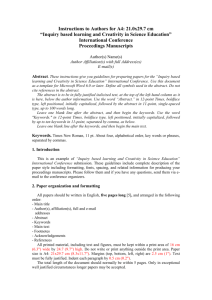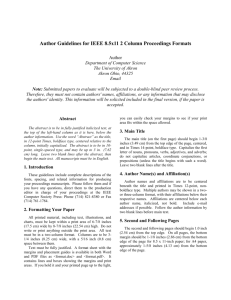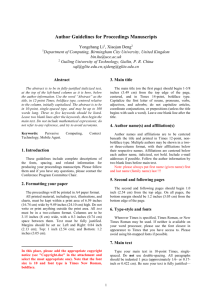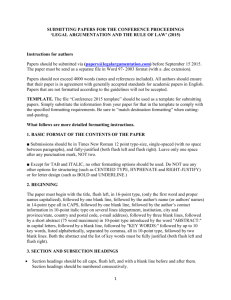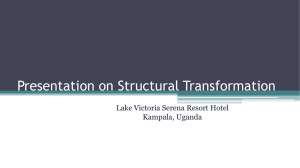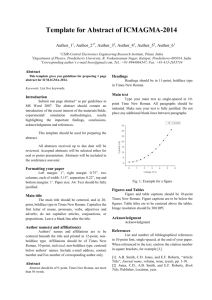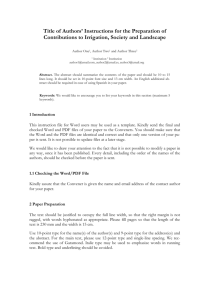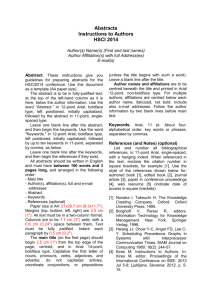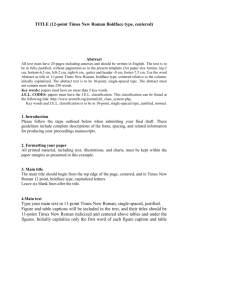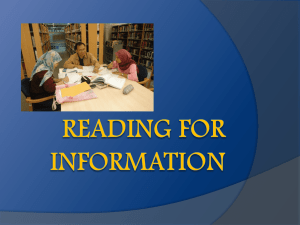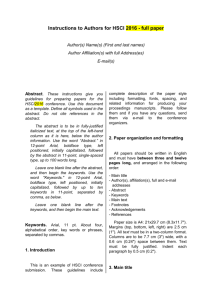Instruction for authors
advertisement
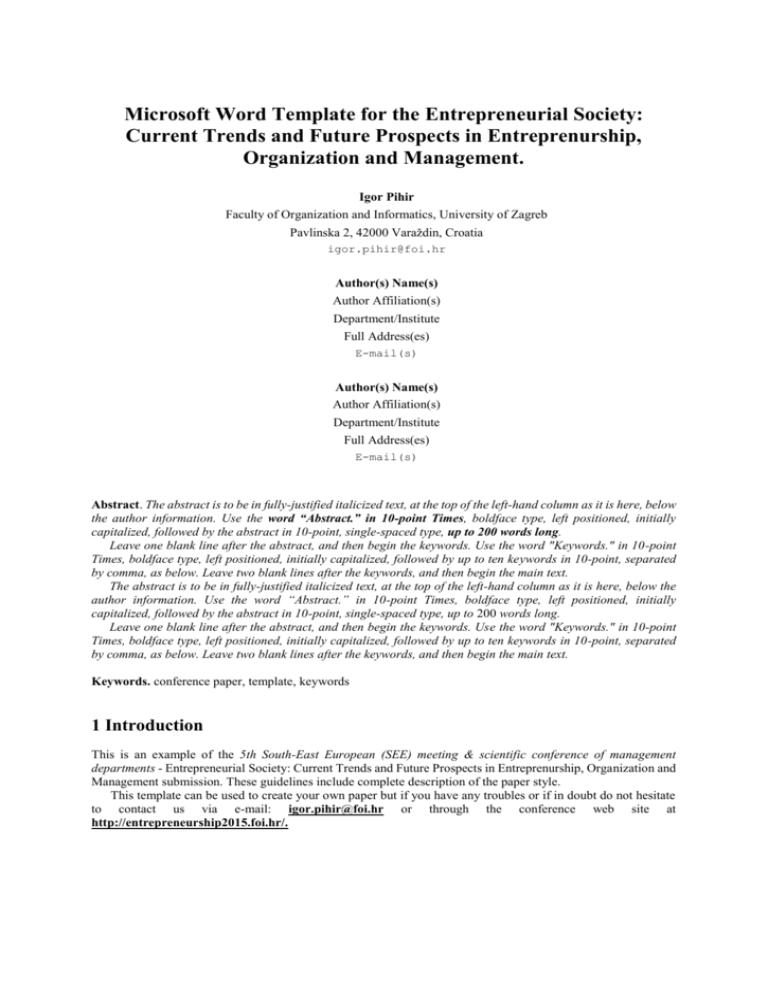
Microsoft Word Template for the Entrepreneurial Society: Current Trends and Future Prospects in Entreprenurship, Organization and Management. Igor Pihir Faculty of Organization and Informatics, University of Zagreb Pavlinska 2, 42000 Varaždin, Croatia igor.pihir@foi.hr Author(s) Name(s) Author Affiliation(s) Department/Institute Full Address(es) E-mail(s) Author(s) Name(s) Author Affiliation(s) Department/Institute Full Address(es) E-mail(s) Abstract. The abstract is to be in fully-justified italicized text, at the top of the left-hand column as it is here, below the author information. Use the word “Abstract.” in 10-point Times, boldface type, left positioned, initially capitalized, followed by the abstract in 10-point, single-spaced type, up to 200 words long. Leave one blank line after the abstract, and then begin the keywords. Use the word "Keywords." in 10-point Times, boldface type, left positioned, initially capitalized, followed by up to ten keywords in 10-point, separated by comma, as below. Leave two blank lines after the keywords, and then begin the main text. The abstract is to be in fully-justified italicized text, at the top of the left-hand column as it is here, below the author information. Use the word “Abstract.” in 10-point Times, boldface type, left positioned, initially capitalized, followed by the abstract in 10-point, single-spaced type, up to 200 words long. Leave one blank line after the abstract, and then begin the keywords. Use the word "Keywords." in 10-point Times, boldface type, left positioned, initially capitalized, followed by up to ten keywords in 10-point, separated by comma, as below. Leave two blank lines after the keywords, and then begin the main text. Keywords. conference paper, template, keywords 1 Introduction This is an example of the 5th South-East European (SEE) meeting & scientific conference of management departments - Entrepreneurial Society: Current Trends and Future Prospects in Entreprenurship, Organization and Management submission. These guidelines include complete description of the paper style. This template can be used to create your own paper but if you have any troubles or if in doubt do not hesitate to contact us via e-mail: igor.pihir@foi.hr or through the conference web site at http://entrepreneurship2015.foi.hr/. 2 Paper organization and for-matting All papers should be up to 10 pages long (approximately 20 000 characters), and arranged in the following order: - Main title - Author(s), affiliation(s), full and e-mail addresses, - Abstract - Keywords - Main text - Footnotes - Acknowledgements - References All printed material, including text and figures, must be kept within a print area of 16 cm (6.3") wide by 24.7 (9.7") high. Do not write or print anything outside the print area. Paper size is A4: 21x29.7 cm (8.3x11.7"). Margins (top, bottom, left, right) are 2.5 cm (1"). Text must be fully justified. Indent each paragraph by 0.5 cm (0.2"). A format sheet with the margins and placement guides is available in Microsoft Word format. It contains lines and boxes showing the margins and print areas. If you hold it and your printed page up to the light, you can easily check your margins to see if your print area fits within the space allowed. The final submission has to be submitted in a single Microsoft Word file with all fonts that are used embedded. 3 Main title The main title (on the first page) should begin 2,5 cm from the top edge of the page, cantered, and in Times 16point, bold face. Capitalize the first letter of nouns, pronouns, verbs, adjectives, and adverbs; do not capitalize articles, coordinate conjunctions, or prepositions (unless the title begins with such a word). Leave a blank line after the title. 4 Author name(s) and affiliation(s) Author names and affiliations are to be centered beneath the title and printed in Times 10-point type. Author names should be in bold face. Multiple authors shall be grouped as shown in the title above. Include also e-mail addresses in 9-point Courier/Typewriter face. 5 Type-style and fonts Wherever Times is specified, Times Roman, Nimbus Roman or Times New Roman may be used. If neither is available on your word processor, please use the font closest in appearance to Times that you have access to. Please avoid using bit-mapped fonts if possible. True-Type 1 fonts are preferred. 6 First-order headings (may extend to the next line) For example, “1 Introduction”, should be Times 14-point boldface, initially capitalized, flush left, with two blank lines before, and one blank line after. Don't use periods (“.”) after the heading number, use them only in lower order headings to separate them from higher order headings. For long headings use a hanging indent aligning the text to the right of the heading number as shown above. All paragraphs in the text should be indented except for the first paragraph in a section. 6.1 Second-order headings As in this heading, they should be Times 12-point boldface, initially capitalized, flush left, with one blank line before, and one after. Use a hanging indent for long headings. 6.1.1 Third-order headings Third-order headings, as in this paragraph, are discouraged. However, if you must use them, use 10-point Times, boldface, initially capitalized, flush left, with one blank line before, and one after. Use a hanging indent for long headings. 7 Main text Type your main text in 10-point Times, single-spaced. Do not use double-spacing. All paragraphs should be indented 0.5 cm (0.2") except for the first paragraph in a section. Be sure your text is fully justified—that is, flush left and flush right. Please do not place any additional blank lines between paragraphs. 7.1 Figures All figures are to be included within the text. Figure captions are to be below the figures, in 10-point Times (or a similar serif font), normal face. Initially capitalize only the first word of each figure caption. Figures are to be numbered consecutively with Arabic numerals throughout the paper, for example: “Figure 1. Database contexts”, and are referred to in the text as Fig. 1, Fig 2, etc. 7.1.1 Illustrations, photographs and graphs Illustrations, photographs and graphs are considered as figures. All graphics should be centered. Your artwork must be in place in the article (preferably printed as part of the text rather than pasted up). If you are using photographs and are able to have halftones made at a print shop, use a 100- or 110-line screen. Supply the best quality photographs and illustrations possible. Penciled lines and very fine lines do not reproduce well. Remember, the quality of the book cannot be better than the originals provided. The conference proceedings will be printed in gray scale, but you can provide images in color since the papers will also be published on CD as full papers. Figure 1. Times, 10 points, normal face 7.2 Tables All tables are to be included within the text. Table titles are to be above the tables, in 10-point Times (or a similar serif font), normal face. Initially capitalize only the first word of each table title. Tables are to be numbered consecutively with Arabic numerals throughout the paper, for example: “Table 1. Input data”. and are referred to in the text as Table 1, Table 2, etc. Column headings should be as brief as possible. 7.3 Equations Equations should be numbered serially on the right-hand side by Arabic numerals in parentheses, and referred to in the text by eq. 1, eq. 2 etc. 3x 2 + 3x 23 = 0 (1) 7.4 Footnotes Use footnotes sparingly (or not at all!) and place them at the bottom of the column on the page on which they are referenced.1 8 Acknowledgments Acknowledgments, if necessary, should appear in a separate paragraph preceding the references . List and number all bibliographical references, alphabetically sorted, in 10-point Times, single-spaced, with a hanging indent, at the end of your paper. Use 12-point paragraph spacing after each reference. When referenced in the text, enclose the citation number in square brackets, for example: [Author, 2007] or [Author and Writer, 2008]. If there are three or more authors like in reference 3 than use [Author at al., 2006]. In case of reference as in 4. with webpage, you should use webauthor’s name or if it is unknown then use institution name as authors name instead. Below you will find examples of citations for different types of bibliographical entities. References [1] Author, A. N. (2007). A Nice Book. The publisher, New York, USA. [2] Author, B; Writer, C. A. (2008). A Journal Article. The Journal, 2(4), pp 250-370, 2008. [3] Author, A; Author, B; Author, C; Author D. (2006). A Conference Article. In Proceedings of a Fine Conference, pp 256-267, Varaždin, Croatia. [4] Webauthor, A. (2011). The Webpage's Title, http://www.web-site.com/path/to/article.html, downloaded: [September, 27th 2011] 1 Use Times 8-point type, single-spaced. To help your readers, avoid using footnotes altogether and include necessary peripheral observations in the text (within parentheses, if you prefer, as in this sentence).
